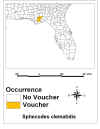These bees are parasites of other Halictidae. Previously (Mitchell 1960), seven taxa were known from Florida. This study finds that four additional taxa have been collected. These bees resemble other Halictidae but have coarse punctation and reduced hairs. Unlike most Halictids (except some Dialictus) in Florida, they often have red on the body.
1. Vertex with a pronounced median tubercle..2
Vertex not tuberculate...3
2. Head and thorax black..Sphecodes heraclei heraclei
Thorax largely red...Sphecodes heraclei ignitus
3. Mandibles entirely simple, or with a very minute and obscure, subapical angle or tooth..4
Mandibles with a distinct, inner, subapical angle or tooth...6
4. Scutum rather coarsely and closely punctate, anterior portion rugose. Sphecodes mandibularis
Scutum more finely or sparsely punctate, the anterior punctures distinct...5
5. Punctures of scutum quite sparse; pleura rather smooth or finely rugose...Sphecodes brachycephalus
Punctures of scutum rather close; pleura coarsely rugose; basal segment of flagellum about half as long as broad...Sphecodes banksii
6. Size larger (8mm or more); scutum not at all sulcate medially..Sphecodes clematidis
Size smaller (6 mm or less); if larger, scutum with a distinct, anterior, median longitudinal sulcus or impression..7
7. Dorsal area of propodeum with very fine, short striae along basal margin; rounded and smooth posteriorly, head very broad..Sphecodes brachycephalus
Dorsal area of propodeum quite coarsely and completely striate or rugose...8
8. Pleura, including hypoepimeral area, densely rugose or very finely reticulate..9
Pleura coarsely reticulate and hypoepimeral area more reticulate than rugose..Sphecodes prosphorus
9. Clypeus very short, median length llittle if any exceeding space between margin and antennae, with only a few scattered punctures.....Sphecodes atlantis
Clypeus more extensive and more closely punctate...Sphecodes cressonii
Sphecodes coronus and Sphecodes fattigi are known only from the male sex.
1. With 2 submarginal cells...Sphecodes mandibularis
With 3 submarginal cells..2
2. Vertex with a pronounced median tubercle..3
Vertex not tuberculate...4
3. Body entirely black..Sphecodes heraclei heraclei
Body ferruginous in large part...Sphecodes heraclei ignitus
4. Segments of flagellum beneath with basal, densely pilose, semicircular facets...Sphecodes prosphorus
Segments of flagellum of the usual form, or the facets very narrow or very obscure..5
5. Basal abdominal tergum well covered with deep and distinct punctures, although possibly fine punctures...6
Basal abdominal tergum with sparse, minute, or lacking punctures...9
Note on key couplet 5-Some species will key out both ways (Sphecodes atlantis and S. mandibularis)
6. Second segment of flagellum nearly or quite as long as basal segment and pedicel combined; larger (6mm or more)...Sphecodes clematidis
Second flagellar segment considerably shorter than basal segment and pedicel combined; smaller (5mm or less)...7
7. Scutum closely punctate throughout...8
Punctures of scutum sparse over median portion of disc..Sphecodes atlantis
8. Usually smaller (4mm); abdomen entirely black or piceous; punctures of basal abdominal tergum covering most of disc...Sphecodes banksii
Somewhat larger (5mm); abdomen ferruginous or testaceous in part; punctures of basal abdominal tergum limited to median portion of disc, apical third of plate impunctate...Sphecodes mandibularis
9. Dorsal area of propodeum finely and incompletely striate, rounded and shining posteriorly...Sphecodes brachycephalus
Dorsal area of propodeum completely and usually coarsely striate or reticulate, with a distinct posterior rim..10
10. Scutum either rugose or closely punctate throughout, interspaces being less than diameter of punctures, in large part...Sphecodes fattigi
Punctures of scutum more widely separated, at least in part...11
11. Abdomen ferruginous or testaceous in part...12
Abdomen entirely black or piceous...13
12. Scutum somewhat greenish; punctures rather sparse posteriorly; tarsi yellow; flagellum pale testaceous; gonostyli with a slender, elongate, apical projection directed toward median line...Sphecodes cressonii
Scutum black; more coarsely and closely punctate; antennae and tarsi relatively dark; gonostyli without a slender apical projection..Sphecodes mandibularis
13. Very small (3.5-4.0mm); tegulae pale testaceous-hyaline..Sphecodes atlantis
Larger (5-6mm); tegulae relatively dark..Sphecodes coronus
County Records: Alachua, Levy, Miami-Dade
Locations:
Dates: March 26-June 17; March: 1, April: 2, May: 3, June: 1
Plants: Erigeron quercifolius, Hydrangea arborescens, Dichromena sp, Lippia nodiflora (UM)
Notes:
County Records: Alachua
Locations:
Dates: April 13
Plants: Melilotus alba
Notes:
County Records: Alachua, Levy, Liberty
Locations:
Dates: April 17-May 8; April:2, May:2
Plants: Quercus laevis
Notes: May be parasitic on Calliopsis andreniformis
County Records: Liberty, Gadsden

Locations:
Dates: April 12, July 31
Plants:
Notes: New state record for Florida. Previously collected in NC.
County Records: Alachua
Locations:
Dates:
Plants:
Notes: New state record for Florida. Previously collected in NC. Only known from the male sex.
County Records: Alachua, Jackson, Levy
Locations:
Dates:
Plants:
Notes: New state record for Florida. Previously collected in NC.
County Records: Leon
Locations:
Dates: April
Plants:
Notes: Endemic to Florida. Only known from the male sex.
County Records: Alachua, Gadsden, Leon
Locations:
Dates: April 3, Sept. 8
Plants:
Notes:
County Records: Alachua, Hernando, Leon, Levy, Miami-Dade, Monroe, Orange, Seminole, Volusia
Locations:
Dates: March-November
Plants:Sabal palmetto, Phytolacca rigida, Opuntia humifusa, Warea carteri, Vernonia blodgettii, Helianthus debilis, and Bidens alba (Graenicher 1930)
Notes: Endemic to SE US (Alabama and Florida)
County Records: Alachua, Leon, Levy, Polk
Locations: Cypress Gardens
Dates: March 2-Aug. 20; March: 4, April: 4, May: 1, July: 1, Aug: 3
Plants: Erigeron quercifolius, Medicago lupulina, Melilotus alba
Notes: This is evidently one of the more variable species, with males having either 2 or 3 submarginal wing cells and showing variation in the punctation of the first basal tergum.
County Records: Miami-Dade
Locations: Opa-Locka
Dates: Oct. 10
Plants:
Notes: New state record for Florida. Previously collected in NC. No photos available at this time.